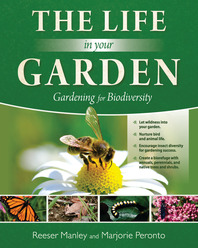
Description
Horticulture experts Reeser Manley and Marjorie Peronto share their own experiences in gardening for biodiversity, placing a strong emphasis on insect diversity as a bellwether of success. Insects comprise 60 percent of Earth’s biodiversity, and they deserve to be recognized as the creatures that run our gardens. It is not the gardener’s job to eliminate insects that munch on leaves, suck the sap from stems, bore holes in fruits, or graze on roots. This is the work of predatory insects and arachnids such as ladybug beetles, hoverfly larvae, praying mantises, certain wasps, and spiders. It is the gardener’s task to cultivate populations of these predators. The Life in Your Garden also describes the functional plants of a garden (with recommendations for understory trees and shrubs throughout North America) and their relationship with garden life, introducing the concept of a “garden insectary.”
That a gardener can be an important steward for our planet is a powerful concept, and here at last is the book that shows us how.
- Let wild pollinators into your garden.
- Nurture butterfly, bird and animal life.
- Encourage insect diversity for self-regulating ecosystem in the garden to help prevent mass extinction.
- No more rototiller use.
- Convert lawn to garden.
- Create a biorefuge with annuals, perennials, and native trees and herbaceous plants.
- A book for all of North America.
Reviews
"Featuring full-color photography throughout, The Life In Your Garden: Gardening for Biodiversity is a guide especially for North American gardeners who seek to benefit the environment through their horticulture. Chapters guide the reader to transforming their garden into a haven of native trees, shrubs, and herbacious plants; providing food and shelter for local plants, insects, birds, and wildlife; controlling plant-eating insects naturally through insect-eating insects and songbirds; and protecting vegetables or small fruits through environmentally-friendly means such as interplantings, floating row covers, cutworm collars, and occasional hand-picking. "Using floating row covers successfully requires knowledge of how insects overwinter. Some Herbivores, like the Colorado potato beetle, spend the winter as adults in the soil near the plants on which they fed as larvae... Other herbivores that overwinter near last year's plant host include the onion maggot, corn rootworm, and flea beetle (which affects many vegetable seedlings). Clearly, crop rotation must be used along with row covers to foil these herbivores." An index enhances this thoroughly accessible and reader-friendly gardening guide, highly recommended for both personal and public library collections. " — The Midwest Book Review


